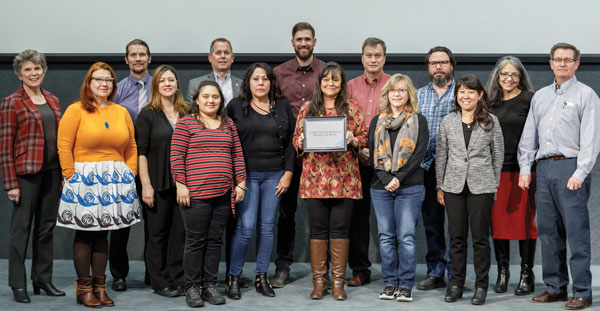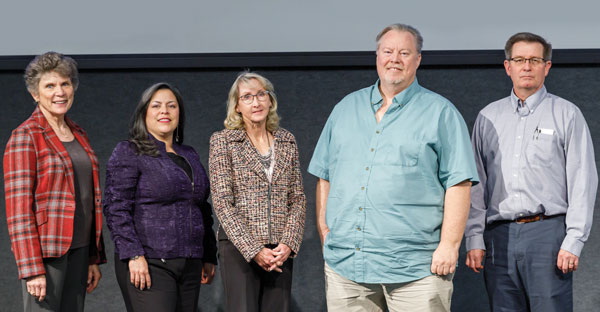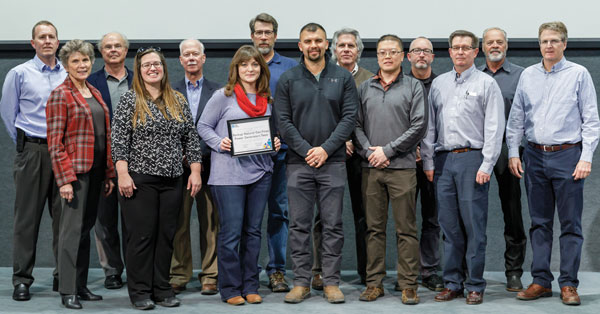Laboratory Operating System program, executives recognize top three lean projects
Sandia’s Laboratory Operating System program honored three teams that demonstrated lean thinking and behavior, improved operations and saved the Labs time and money in fiscal year 2019.
Labs Director James S. Peery, Deputy Labs Director Dori Ellis and Business Excellence Director Joan Tafoya honored the teams at a ceremony in February, highlighting their innovations and how the teams challenged the status quo.
“We want to reinforce a culture of continuous improvement and problem solving by recognizing projects that boil to the top as being the best, from our lens,” said LOS manager Meghan Estochen. Her team reviewed projects reported in the Continuous Sandia Improvements tool and the Performance Evaluation Assurance Report to determine the top three lean improvements for the year.
“We look at it from the perspective of what projects are saving money, reducing cycle time or demonstrating cross-division collaboration and partnerships,” Meghan said.
The three top projects selected accelerated the NNSA diamond stamp delegation process, established standardized hardware and software options and replaced nearly obsolete generators with new backup natural-gas-fired power generators.
Saving production time, money

When a product is procured or manufactured by Sandia, it is verified to ensure it meets all requirements for use by NNSA and the U.S. military. If the product meets all requirements, it receives a diamond stamp, meaning it is worthy of use in the nation’s stockpile.
Prior to Sandia receiving diamond stamp delegation from NNSA, it took a week for each part to be inspected and approved by Sandia’s weapon quality assurance department, and an additional week for the Sandia Field Office to inspect and approve each part, said manager Scott Lager.
In order to receive diamond stamp delegation and speed up this process, Scott said Sandia went through audits by NNSA to prove the Labs could inspect and approve almost all parts. Now, Sandia diamond stamps about 75% of all parts, reducing a week of inspection time for those products.
“This will save the Labs nearly $5 million over three years,” Scott said, adding that this is a conservative estimate. “This also enables us to meet production demand. If we didn’t get the delegation, we wouldn’t have been able to meet scheduled demands from NNSA to get the products out the door.”
Standardizing hardware, software packages

A team led by IT architecture strategy manager John Miner evaluated Sandia hardware and software packages to determined how to standardize many of them. The team determined which packages were under-utilized or not used at all, and those options were eliminated.
The team’s evaluations increased standardization, reduced unused devices and identified unnecessary duplicate software requests, leading to a 42% increase in hardware standardization, a 33% increase in upgraded software and identification of 100 unused devices that were disconnected. In addition, John said duplicate software requests have been avoided and the Labs is now developing standards to make software and hardware solutions obvious and available.
Optimizing backup generators

Generators that back up many buildings in Tech Area 1 were becoming obsolete, so the facilities engineering team evaluated several options to solve that problem. They looked at several bid proposals and selected one that would work for the Labs, reduce emissions and cost $1.78 million less than other proposals. Facilities engineering project manager Emily Kowalchuk said four old generators were removed and two new natural-gas-fired power generators were installed over a year-long project.
“I am proud to provide reliable backup energy to the buildings and systems in Tech Area 1 that need to stay operational if the primary power systems were to go down,” Emily said.
“The new generators also produce fewer emissions and increase overall system capacity, as well as reliability. We removed an underground diesel fuel tank as part of this project, and this reduces future environmental risk. The project was completed under the approved budget by $818,000, or roughly 10% of the final cost.”
Using the Continuous Sandia Improvements tool
Teams are encouraged to submit their improvement projects using Sandia’s internal Continuous Sandia Improvements tool at csia.sandia.gov. The projects will be evaluated by the Laboratory Operating System program team at the end of the fiscal year.
The top three improvements for fiscal year 2020 will be recognized in November. Employees can contact LOS manager Meghan Estochen.